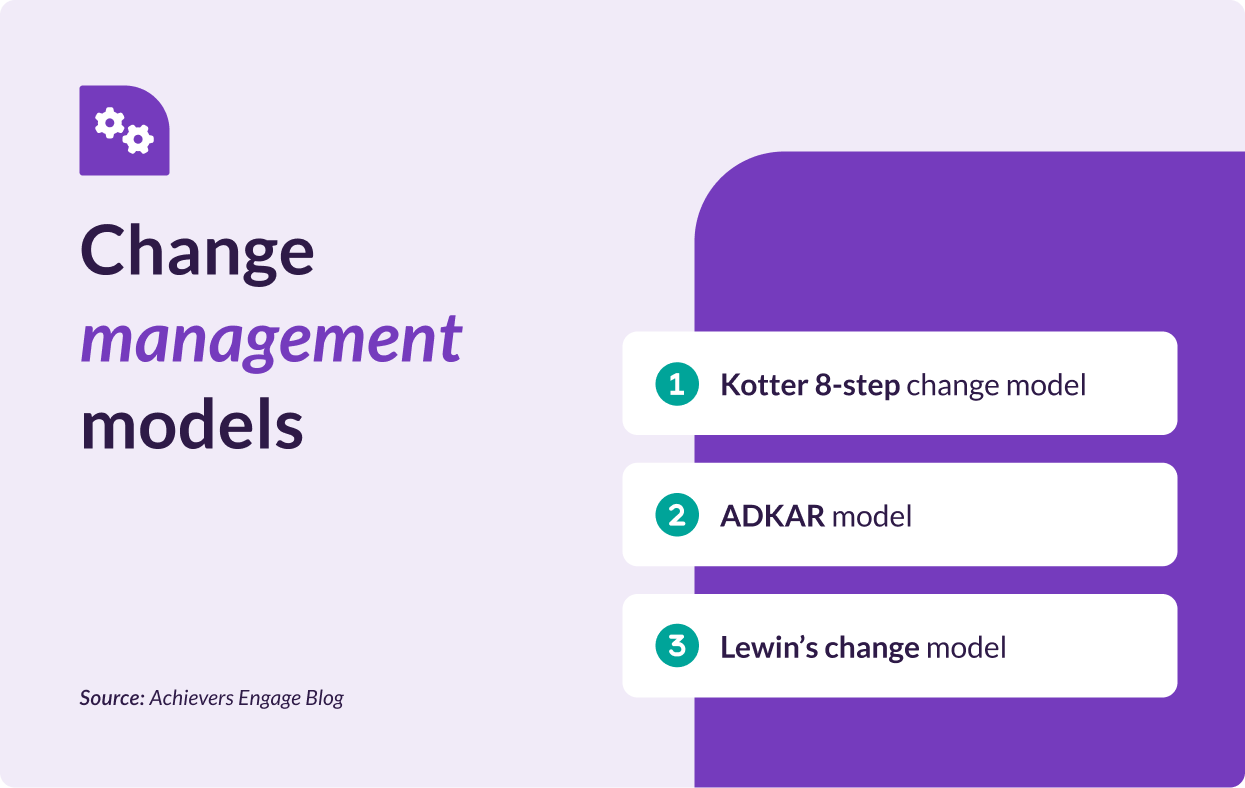Table of contents
Any organization that lasts long is bound to undergo multiple changes — and the best have the mindset and processes in place to adapt and make the most of each one that comes their way. Whether driven by new technology, movements in the market, or internal necessity, a solid change management strategy smooths transitions and equips employees for continued success. Mastering change management will help your company swiftly respond to external pressures, embrace innovation, and stay productive through good times and bad.
What is change management?
Change management is a set of processes for successfully navigating your company and employees through the waters of organizational change. At its core, change management is about addressing the human side of change. HR professionals and other people leaders must understand how changes impact employees, anticipate their reactions, and provide the necessary support to help them adjust. Successful change management involves employees in the decision-making process before change is made and continues to incorporate their feedback as transitions progress.

Change management models
There’s no need to reinvent the wheel when it comes to change management. Instead, follow the core principles found in a proven change management model that fits the needs of your company. Here are three of the most popular frameworks, each of which offers a unique approach to handling change.
1. Kotter 8-step change model
Dr. John Kotter is a professor from the Harvard business school whose detailed model guides organizations through every part of change management. It includes eight steps:
- Create a sense of urgency. Establish a sense of urgency around the need for change.
- Build a guiding coalition. Assemble a group with enough authority to lead the change effort.
- Form a strategic vision. Develop a clear vision and strategy for change that employees can understand and buy into.
- Enlist a volunteer army. Motivate individual employees and align them behind the change that’s coming.
- Enable action by removing barriers. Identify and eliminate the barriers to change at your company.
- Generate short-term wins. Work to deliver and highlight tangible successes early in the change process.
- Sustain acceleration. Leverage these early successes to drive further change.
- Institute change. Reinforce change by recognizing team members who embrace it and highlighting connections with organizational success.
2. ADKAR model
The ADKAR model, created by Prosci, facilitates organizational change by acknowledging that large-scale shifts can only occur when individuals change their own behavior. ADKAR stands for the following:
- Awareness. Make individuals aware of the need for change.
- Desire. Encourage individuals to support and participate in the change.
- Knowledge. Teach individuals how to change.
- Ability. Provide individuals with the ability to implement new skills and behaviors.
- Reinforcement. Reinforce and sustain the change.
3. Lewin’s change model
Kurt Lewin’s model for change management takes a relatively simple approach by dividing the process into three easy-to-understand stages:
- Unfreeze. Prepare the organization for change by acknowledging the need for it and spreading awareness of this need. The goal is to create room for change before implementing it.
- Change. The organization then puts the change into practice, focusing on supporting employees to ensure they’re able to adapt well.
- Refreeze. The final stage is about creating lasting change, making it a part of organizational culture and rewarding team members who adopt new behaviors.
How to build a great change management process
Creating a change management process that gets results requires adapting these frameworks to suit the needs of your company and the particular change you’re looking to implement. In every case, the first step is developing a well-crafted change management plan. This provides a roadmap all team members can follow as the change process kicks off and moves forward.
Before starting on the plan, identify all stakeholders affected by the change and involve them in the planning process to build a sense of ownership and minimize resistance. Then define the reasons for the change, desired outcomes, and how it aligns with your organization’s business goals. The plan should outline the steps and actions required to implement the change, including timelines, resources, and responsibilities. And it should include strategies related to ongoing training and support, monitoring progress, and, of course, communication.
Unaddressed concerns and misconceptions are some of the biggest roadblocks to effective change management. Practice transparency and honestly communicate information about the change well in advance, including the rationale behind it, the benefits it will bring, and how it will impact employees. Giving regular updates and keeping a variety of communication channels open helps build trust and reduce employee uncertainty. During this process, emphasize that leaders need to provide concrete answers to issues team members raise — and educate them on how to respond to specific concerns employees are likely to bring up.
Communication should be two-way, as soliciting and acting on employee feedback is crucial during every phase of the change management process. Employees are often the most impacted by organizational changes, and they can provide valuable insights into unforeseen pitfalls and potential opportunities. Collecting employee input in real time is within reach for every company with tools like pulse surveys and AI-powered HR chatbots — which are often included in today’s employee engagement platforms. Acting on the feedback received is equally important: when employees see that their input leads to tangible adjustments, it proves that their voices actually matter.
Finally, ensure that the change your company worked so hard to make happen has a lasting impact by recognizing team members who buy into it. When employees demonstrate new behaviors that align with the change you’re striving towards, leaders should show appreciation publicly with words of thanks and tangible rewards. This encourages other workers to follow suit and keeps driving change forward.
There’s no need for leaders and other team members to watch and wait until an opportunity for recognition comes their way, either. With an employee recognition and rewards platform, every moment of appreciation is available for all team members to jointly celebrate in a centralized location accessible from anywhere with an internet connection. Top-of-the-line solutions even let employees reward those who exemplify the change your company wants to see with exciting merchandise and experiences at the click of a button, thanks to points-based reward systems and built-in marketplaces with millions of options to choose from.
Navigate change with a real understanding of your workforce
If you want to make the experience of change at your organization as smooth and engaging for employees as possible, look no further than the Achievers Employee Experience Platform. It makes it easy for all team members to build excitement for change with Achievers Recognize, a recognition solution with best-in-class rewards features that delivers results you can measure. Combined with Achievers Listen, an employee engagement tool that gives your people leaders the data on how change is progressing and the ability to act on it, the Achievers Employee Experience Platform includes everything your company needs to meet the unique needs of your workforce before, during, and after change.
See how you can integrate change management with employee recognition and feedback with a free demo.



